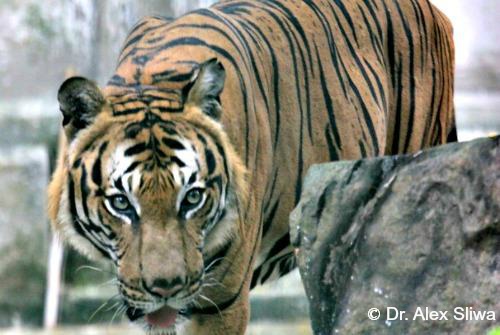- HB Length: 146-290 cm (57-114″)
- Tail Length: 72-109 cm (28-43″)
- Height: 85-100 cm (34-40″)
- Weight: 75-325 kg (165-716 lbs)
- Pop. Trend: Decreasing
Tigers Panthera tigris , with their bright orange colour, familiar striped pattern, and large size, are the most easily recognizable wild cat to most people. The male Siberian Tiger is the largest of all cats, with an all-time record of 384 kg.
Their large, powerful body is covered with dark brown to black vertical striping on a ground colour of light reddish yellow to ochre. The underparts and inner sides of the limbs are creamy white in colour, sometimes with a light yellow tinge. The head has a domed forehead and relatively long muzzle; the face is framed by a ruff of longer hair; and the nose pad is pink, sometimes with black spots. The irises are yellow, and the pupils are round. Their short, rounded ears have black backsides, with conspicuous white spots in the middle. Forelimbs are more powerfully built than the hind limbs, and the footpads are large. The relatively long tail is patterned with stripes and rings of black; the tip is usually black.
Distribution

These magnificent cats are now restricted to just 7% of their historic range. They are now found from western India to the Himalayas, through Indochina to Malaysia, Sumatra, the Russian Far East and northeast China. They are extinct in Bali (1940’s), Central Asia (1968) and Java (1980’s) and likely extinct in south-central China.
Tigers are found in areas with dense cover such as temperate and tropical forests, dense floodplain grassland, thickets, scrub, marshes, reed beds and mangroves. They avoid areas of human modified habitats such as cropland and palm oil plantations. In the Himalayas they have been recorded up to 4,100 m.
Recorded territory sizes vary from 10 km2 in Nepal to 2,058 km2 in Russia. Densities of populations, even in high quality habitat, are often affected due to human hunting of their prey. Estimates vary from 2.6 tigers per 100 km2 in tropical forest where poaching is prevalent, 1.4 per 100 km2 in temperate Russian Forest to 19 cats per 100 km2 in well protected forest in India.
Ecology
Tigers were more plentiful in the past when forests and grasslands supported flourishing populations of the various species preyed upon by the big cats. Fossil evidence suggests the tiger evolved in Siberia, some remains having been found as far north as the edge of the Arctic Ocean. Their habit of resting in or near water or in the cooler interiors of forests during the heat of the day, suggests they overheat easily and evolved in a cooler climate.
They are mainly nocturnal, but may be active during the day, especially in winter in the northern part of their range. They appear to depend more on sight and hearing than smell when hunting. Like many other cats, they carefully stalk their prey, using all available cover and blending in with the vegetation. The Tiger approaches from the side or the rear of its prey, attempting to get as close as possible before leaping on the victim to apply a neck or throat bite.
In certain rare situations, some Tigers will kill humans, but these are usually old or injured animals that can no longer hunt wild prey. Tigers probably kill more people than any other large carnivore, mainly in India where human populations are so dense and often use Tiger habitat intensively.
Tigers often drag their prey to cover, usually near water, so that they can alternate between eating and drinking. They often stay near the carcass to prevent it being eaten by scavengers, and will cover the remains with vegetation when not eating. The three prerequisites that must be met for a viable Tiger home range include: sufficient cover, year round access to water, and an assured supply of large prey.
Reproduction
Mating may occur at any time of the year, but is most frequently seen from November to April. Females enter oestrous at intervals of three to nine weeks, and receptivity lasts three to six days. Dens are usually constructed beneath fallen trees, in rock shelters, or in thick vegetation. One to seven, usually two or three, cubs are born after a gestation period of 93 – 111 days. The cubs weigh 760 – 1600 grams at birth, and open their eyes between six and 14 days. They nurse for three to six months, and begin to hunt with the female at 11 to 12 months. The young separate from their mother between 18 and 24 months, with females reaching sexual maturity between 36 and 48 months, and males taking 48 – 60 months. Lifespan in the wild is 16 years for females and 12 for males. Tigers have lived to 26 years of age in captivity.
Conservation
The most endangered large cat species, 70% of Tigers are now living in 0.5% of their historic range.
The Tiger is sinking faster and faster towards extinction because of ruthless and well organized poaching for bones and other parts for Chinese traditional medicine. This is compounded by widespread hunting of their prey to feed the massive demand for bush meat, especially in southeast Asia. Combined with loss of habitat to forestry, commercial palm plantations and agriculture, Tigers may be doomed to disappear completely from the wild in a few decades.
In November 2010, a Tiger Summit was held in St. Petersburg, Russia where the 13 Tiger Range Countries adopted a Global Tiger Recovery Program. The goal is to effectively double the number of wild Tigers by 2022 through actions to: i) effectively preserve, manage, enhance and protect Tiger habitats; ii) eradicate poaching, smuggling and illegal trade of Tigers, their parts and derivatives; iii) cooperate in trans-boundary landscape management and in combating illegal trade; iv) engage with indigenous and local communities; v) increase the effectiveness of Tiger and habitat management; and vi) restore Tigers to their former range.
The Tiger Summit was attended by Heads of State including Russia, China, Laos, Nepal and Bangladesh, and represents a policy commitment to Tiger conservation of unprecedented significance.
Tigers are one of the world’s most endangered animals and are classed as Endangered Globally (2008), and Critically Endangered (2008) in Russia, China and Sumatra.
Read more about Tigers and how Panthera.org is working to provide them a future.
Range Map IUCN Red List (2008)
Updated 2013


Talk to Us!